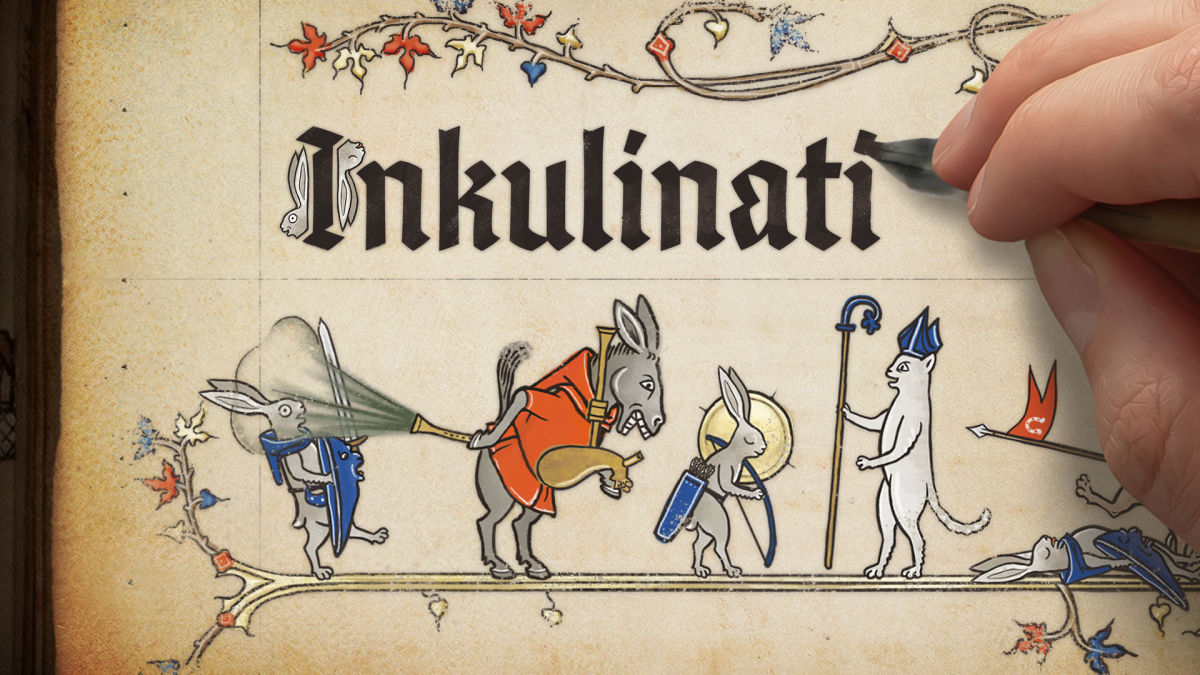Have you ever wanted to play a turn-based strategy game where historically accurate medieval illustrations come to life? How about one where you can fart on your enemies to win? If your answer is “yes” to either of those, then Inkulinati has you covered.
Inkulinati (PC [Reviewed], Nintendo Switch, PS4, PS5, Xbox Series X|S)
Developer: Yaza Games
Publisher: Daedalic Entertainment
Released: February 22, 2024
MSRP: $24.99
Inkulinati is a portmanteau of “ink” and “illuminati” — a reference to illuminated medieval manuscripts with elaborate illustrations in the margins. You play as an Inkulinati, someone who uses special Living Ink to draw fanciful creatures in the margins of a page. These creatures come alive and can be commanded in battles against other creatures and Inkulinati. The campaign sees you on a journey to defeat other Inkulinati to become a master, with three playthroughs required to see the true ending of Inkulinati.
The combat is entirely turn-based. You play as a tiny representation of yourself, drawn onto the lower margin of a page. This “Tiny” can’t move on its own, but it has a few abilities that you’re able to customize. You can also summon additional units by drawing them with Living Ink. These units are able to move on their own, and each type of unit has unique attacks and abilities. They all have fun names, too.

I was surprised and delighted to find that combat is more complex than it first appears. You can defeat an enemy with hard-hitting attacks or simply push them off the edge of the page, killing them instantly. Stage layouts aren’t always simple, either. You can block enemy movements or attacks with a variety of obstacles. Units can use ladders to traverse different levels, or simply fly if they have wings. I liked that I needed to pause and think about where to place my units, how to approach obstacles, and where enemies would go if I pushed them. Inkulinati feels almost like chess, but with more sword-wielding rabbits.
The medieval theming is consistent in every aspect of Inkulinati, down to the variety of status effects. Units can be infected with the plague, taking damage over time, or afflicted with Danse Macabre, which forces them to move against their will.
My favorite unit is the snail. The snail consumes and deletes anything in front of it — enemy or otherwise — regardless of how much health it has. If you can maneuver a snail in front of your opponent, you win.
Snails may be the most overpowered animal, but Inkulinati is full of other creatures, too. There are rabbits, dogs, foxes, fish, and monkeys, all with unique weapons and abilities. You’ll also face other fantastic creatures like dragons, devils, bees with little hats, and, uh, whatever this thing is.

All of the art is based on real historical art in the margins of medieval manuscripts. So when you see devils with human faces on their bums, that’s because such things have been depicted in real ancient texts. As an added bonus, Inkulinati features the voice of Hildegard von Blingin’, known for her medieval-style covers of modern songs.

Not only is the art full of medieval flair, the humor is too. It turns out old monks appreciated a good fart joke just as much as we do today. Certain units have farts built into their movesets, while others can moon enemies to stun them. Over the past few days, I’ve spammed my friends with screenshots from Inkulinati, showcasing all the absurd things you can do to win your illustrated duels.
A steep but rewarding learning curve
Of course, you need to learn how to use the fun game mechanics before you can play around with them. To do this, you’ll want to play through Inkulinati’s Academy, which acts as a tutorial. The Academy does a good job of teaching you what you need to know, but it is quite extensive. It took me around an hour and a half to get through most of the basic Academy and a few of the intermediate tutorials.
The learning curve can be a bit steep at first, which might turn a fair few off of Inkulinati. But, if you don’t mind taking your time to read and think things through, you’re rewarded with some honestly fun logic puzzles and creative gameplay opportunities.

Are multiple playthroughs really necessary?
My other criticism is how Inkulinati requires three playthroughs to really complete. The first playthrough is five acts long, with each act being a series of stages. These five acts end on a cliffhanger, with a prompt to replay the story again. Completing a playthrough unlocks new units and abilities that will enrich your next one.
The second playthrough consists of six acts. The first five acts feature mostly the same story as the first playthrough, albeit with different stages. The sixth act adds a bit more to the story. After completing the second playthrough, I’m prompted to play through the campaign again.
The third playthrough has seven acts, the first six of which follow the same story as in my second playthrough. Only the seventh act is new, and the ending concludes the story for good.

I do appreciate that the stages themselves differ between playthroughs. It’s not like I’m doing the exact same thing three times. I’m also able to use abilities and units that I’ve unlocked during previous playthroughs. But I would rather just have one longer campaign or a series of random stages than play through the same story three times.
Inkulinati has its quirks, but it’s dripping with charm. For a small studio’s first game, it’s a solid experience that makes me look forward to what Yaza Games comes up with in the future. The game is on Xbox Game Pass, so it can’t hurt to try it out. Inkulinati’s deceptively robust combat and Monty Python-esque humor makes for a delightful experience that is well worth your time.





Published: Mar 15, 2024 11:42 am